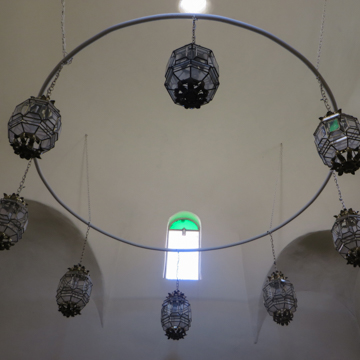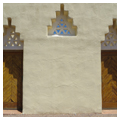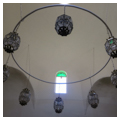You are here
Dar al Islam Islamic Education Center
The mosque and madrasa built by the Egyptian architect Hassan Fathy (1900–1989) at Dar al Islam in Abiquiú are based on Nubian vernacular models that return New Mexico’s traditions of adobe construction to their Arabic origins in North Africa. Incorporated in 1979, Dar al Islam is an Islamic religious and educational institution that was envisioned as a residential community for American Muslims. The mosque and madrasa are Fathy’s only built work in the Western Hemisphere; he also designed the master plan for a village that was never executed.
Trained as an architect in Cairo to work in various European styles, Fathy began experimenting in the 1930s with an architecture inspired by the indigenous building traditions of Egypt. Such functional elements as the wind-catcher ( mālqāf) and the lattice screen ( māshrābīyyāh) combined with vaults and domes built of mud bricks without formwork to provide an inexpensive and climatically appropriate alternative to industrial structures of reinforced concrete. Fathy attracted the attention of the Department of Antiquities, which hired him to design New Gourna in 1948. In an effort to end grave-robbing at the archaeological site of Luxor by inhabitants of the nearby village of Gourna, the villagers were resettled away from Luxor. New Gourna became the prototype for other rural building projects in the Middle East, and its construction was chronicled in Fathy’s book, Architecture for the Poor, published in English in 1972. During his lifetime, Hassan Fathy attained international fame and was a dominant, if controversial, figure in Egyptian architecture.
The original mission of Dar al Islam was to offer a place where American Muslims could practice their religion in a residential community. It was also intended to be a space where visitors could focus on their spiritual practice and take advantage of educational programs in Islamic arts and traditional building techniques. The master plan anticipated that the campus would contain a mosque ( masjid), a school ( madrasa), a dormitory ( riwaq), housing for 150 families, a women’s center, a public bath, a hotel, and a center for Islamic crafts. The organization purchased an 8,500-acre ranch on the north and south sides of the Chama River with funds donated by private individuals including a large grant from King Khalid of Saudi Arabia. Most of the ranch was sold in 2005–2006 and the property presently includes about 1,350 acres.
Fathy arrived in Abiquiú in 1980, accompanied by two Nubian master masons, Allahadin Mustapha Muhammed and Abdul Jalil Mousa. They were joined by people who came from around the United States and Mexico to help build the mosque and learn the traditional practices of Egyptian mud-brick building; a large crew worked with Muhammed and Mousa on the 2,260-square-foot structure over a two-week period. In 1981, Fathy returned with a master plan for Dar al Islam and began construction of a 17,045-square-foot madrasa that includes a library connected to the mosque. As construction progressed, adjustments were made to Fathy’s plans. The two-week training period proved insufficient to teach students how to build adobe vaults and domes without formwork. Foam insulation was added to the roof and small pumice bricks were substituted for adobe in several of the domes.
The plan of both the mosque and the madrasa, and their use of vaults, domes, and claustra-work (window tracery) built with adobe all relate to precedents in New Gourna. The mosque’s prayer niche ( mihrab) is placed under a large Sassanid dome on squinches, which is flanked by two catenary vaults. The rest of the mosque is roofed with six Byzantine domes on pendentives. Dar al Islam was positively reviewed in Adobe Today, Architectural Record, and Progressive Architecture, among other magazines , as well as by the Egyptian press.
Nearly a dozen families moved to Dar al Islam in the 1980s. Most of the adults were employed in construction or in operating a small school begun as a project in curriculum development. By 1987, the madrasa had six full-time teachers and forty-four students. Dar al Islam also helped start several small businesses in Abiquiú, but in 1990 changed its mission from a residential community to an educational center that hosts religious retreats and offers a venue for classes, lectures, and programs focusing on Islam and Islamic culture.
Writing Credits
If SAH Archipedia has been useful to you, please consider supporting it.
SAH Archipedia tells the story of the United States through its buildings, landscapes, and cities. This freely available resource empowers the public with authoritative knowledge that deepens their understanding and appreciation of the built environment. But the Society of Architectural Historians, which created SAH Archipedia with University of Virginia Press, needs your support to maintain the high-caliber research, writing, photography, cartography, editing, design, and programming that make SAH Archipedia a trusted online resource available to all who value the history of place, heritage tourism, and learning.





























